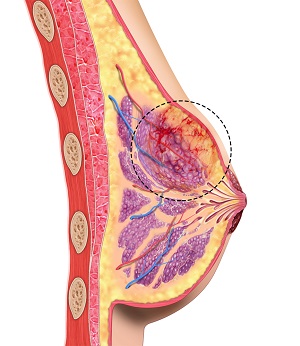
What is Triple Negative Breast Cancer?
Triple negative breast cancer is a rare form of breast cancer that tests negative for oestrogen and progesterone receptors, as well as HER2 receptors.
Healthy breast cells and most breast cancers produce receptors (special proteins on the cell surface) that bind to hormones such as oestrogen or progesterone. They also produce HER2 receptors that bind to other substances. Binding activates processes that help cells grow and multiply and can be targeted by specific therapies to prevent cancer cells from growing and multiplying. Triple negative breast cancers do not have estrogen, progesterone or HER2 receptors so such therapies are ineffective.
What are the Characteristics of Triple Negative Breast Cancer?
Triple negative breast cancers are usually:
- Aggressive: They spread more easily and often recur after treatment.
- High-grade cancers: They are fast-growing, spread quickly and have a worse prognosis.
Similar to cells lining the milk ducts
Who is More Likely to Develop Triple Negative Breast Cancer?
Though anyone can develop triple negative breast cancer, the likelihood is higher if you:
- Are under the age of 40 to 50
- Are of African descent
- Have a genetic mutation of the BRCA1 gene which indicates a higher risk of breast cancer
What are the Symptoms of Triple Negative Breast Cancer?
Symptoms of triple negative breast cancer are common to other types of breast cancer and include:
- A hard lump in the breast that doesn’t hurt
- Changes in the shape, size or feel of the nipple or breast, which may include redness or dimpling
- Discharge of fluid from the nipple – clear, bloody, yellow or green
- Pain or discomfort in the breast
- Bone pain
- Skin ulcerations on the breast
- Weight loss
How is Triple Negative Breast Cancer Diagnosed?
Your doctor will review your symptoms and medical history, and perform a physical examination including an examination of your breasts and armpits for lumps and other abnormalities. Diagnostic tests that may be performed include:
- Mammogram
- Breast ultrasound, to determine if a lump is a solid mass or fluid-filled cyst
- Biopsy, for a definitive diagnosis and to determine the grade of cancer, type of cells involved and the presence of hormone receptors, which will help determine the treatment
- Breast MRI
Other tests may be ordered to stage and determine the extent of cancer. These may include:
- Blood tests
- Mammogram
- Imaging studies such as MRI, CT and PET scan
- Bone scan
Based on the results of these tests, your cancer will be staged from 0 to IV, indicating if it is invasive, non-invasive or metastatic. Staging helps in determining the appropriate treatment plan.
What are the Treatment Options for Triple Negative Breast Cancer?
Though specific therapies, such as hormone therapy or those that target HER2 receptors, do not work on triple negative breast cancers, these types of cancers respond to:
- Surgery
- Chemotherapy
- Radiation therapy
- Newly available treatments
Surgeries to treat Triple Negative Breast Cancer
Surgery to treat breast cancer may include the following options:
- Lumpectomy: removal of the tumour along with a small margin of healthy tissue
- Mastectomy: removal of the entire breast tissue. For aesthetical reasons, breast-conserving surgery may be performed.
- Sentinel node biopsy: removal of lymph nodes closest to the tumour to determine the spread of the cancer
- Axillary lymph node dissection: further removal of lymph nodes in your armpit
- Contralateral prophylactic mastectomy: removal of both breasts – the breast with cancer as well as the healthy breast to avoid the risk of developing cancer in the other breast as well
Chemotherapy to treat Triple Negative Breast Cancer
Chemotherapy, the use of drugs to kill cancer cells, is found to be effective in treating triple negative breast cancer. It is sometimes given before surgery to shrink the tumour (Neoadjuvant therapy). You may then need only a lumpectomy instead of a mastectomy.
Radiation Therapy to treat Triple Negative Breast Cancer
Radiation therapy involves the use of high-energy radiation waves to kill cancer cells. This can be administered by external beam radiation or brachytherapy, where a radioactive substance is placed inside your body.
Your doctor will usually recommend a combination of therapies to help treat triple negative breast cancer more effectively. To help you fight cancer more effectively, a healthy diet, regular exercise, limited alcohol intake as well as other healthy lifestyle choices are also recommended.
What are the New Treatments being Researched for Triple Negative Breast Cancer?
New treatments that target cancer cell processes include:
- PARP inhibitors: Poly ADP-ribose polymerase inhibitors prevent cancer cells from repairing themselves after chemotherapy.
- VEGF inhibitors: Vascular endothelial growth factor inhibitors prevent the formation of new blood vessels that supply cancer cells with oxygen and nutrients.
- EGFR targeted therapies: Epidermal growth factor receptor-targeted therapies block EGFR receptor proteins that receive growth signals.
What is the Prognosis of Triple Negative Breast Cancer?
Triple negative breast cancer has a higher chance of recurring after treatment. Though it is aggressive by nature, there is no evidence that aggressive treatments such as mastectomy vs lumpectomy or high-dose chemotherapy have better outcomes. Certain studies show that hormone receptor-negative cancers (which can also include triple negative breast cancers) respond well to chemotherapy while other studies show that chemotherapy before surgery is more effective. The various new therapies in the pipeline can improve the outcomes of triple negative breast cancer.
